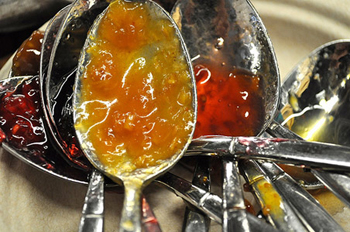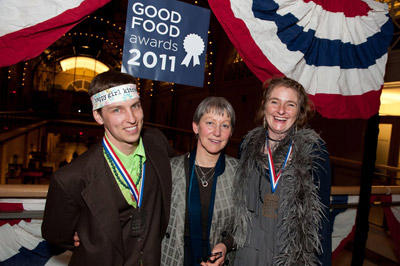Good Food Awards Spotlight Food Crafters
Brie Mazurek, CUESA Staff
January 13, 2012
 This weekend, hundreds of food artisans from all corners of the country, from Alaska to Florida to our Bay Area backyard, will pack the Ferry Building for the Good Food Awards, a national honor that recognizes products that are not only delicious but also authentic and sustainably produced.
This weekend, hundreds of food artisans from all corners of the country, from Alaska to Florida to our Bay Area backyard, will pack the Ferry Building for the Good Food Awards, a national honor that recognizes products that are not only delicious but also authentic and sustainably produced.
“We are already familiar with USDA organic and fair trade certification, and those are important,” says Good Food Awards director Sarah Weiner. “But it’s disappointing when you buy a product because you see that seal, and the taste is not what you expected. Consumers are trying to put their money where their values are, and I think that an award that brings together taste, sustainability, and social responsibility can really help people find the food they want.”
The seeds of the Good Food Awards were planted at 2008’s Slow Food Nation, where Weiner served as content director. After the event, organizers observed that they’d created a much-needed space for food crafters, where ideas could be exchanged, challenges shared, and community built.
Developed by the Seedling Projects, a nonprofit dedicated to promoting collaboration in the food movement, the Good Food Awards launched in 2011. In their inaugural year, the awards attracted more than 780 entries from 41 states and honored 71 winners, including Ferry Plaza Farmers Market vendors Happy Girl Kitchen Co., Blue Bottle Coffee Co., and Cowgirl Creamery. “One of the best aspects of the awards was meeting the other small producers who emerged from across the country,” says Happy Girl’s Todd Champagne. “It was very inspiring.”
This year, the Good Food Awards winnowed more than 926 entries down to 144 finalists in the categories of beer, charcuterie, cheese, chocolate, coffee, pickles, preserves, and spirits. On February 13, 99 winners (including Ferry Plaza artisans Farmhouse Culture, Fatted Calf, and Saint Benoît Yogurt) were honored at a gala reception, hosted by Ruth Reichl at the Ferry Building, and the following day market-goers sampled the winning products at the Good Food Awards Marketplace, hosted by CUESA at the Ferry Plaza Farmers Market. A Beer & Spirits Garden also took place in the Grand Hall.
Taste Meets Sustainability
Entrants are judged in a blind tasting by a panel of food movement leaders, chefs, journalists, farmers, and food producers, and carefully evaluated for authenticity and sustainability. The criteria do not include third-party certifications such as organic, but they follow similar standards while being mindful of the specific sourcing challenges of each craft. (Judging criteria can be found here.)
 In the preserves category, for example, most ingredients must be free of artificial ingredients, sourced or foraged locally (with the exception of sugar, pectin, and spices), be grown without the use of synthetic pesticides, herbicides, or GMOs, and demonstrate respect for seasonality. Contestants must provide specifics on every detail of production, from how the jars are sealed to the ratio of sugar to fruit.
In the preserves category, for example, most ingredients must be free of artificial ingredients, sourced or foraged locally (with the exception of sugar, pectin, and spices), be grown without the use of synthetic pesticides, herbicides, or GMOs, and demonstrate respect for seasonality. Contestants must provide specifics on every detail of production, from how the jars are sealed to the ratio of sugar to fruit.
“You can’t tell when you pick up a jar of jam at the store whether someone is using commercial pectin, or fresh or frozen fruit, so we ask some of those questions,” says preserves-maker June Taylor, who served on the preserves committee and judging panel this year.
A Stepping Stone
The award’s blue seal has meant different things for 2011’s winners, and sometimes it has caused growing pains. For Stephanie McClenny of Confituras, a small preserves-maker in Austin, Texas, winning a Good Food Award “pushed her company to a big growth phase, forcing them to focus on a goal and how they wanted to grow,” says Weiner.
Ann’s Specialty Raspberries, a sustainability-oriented farm in Fredericktown, Ohio, produced only 300 jars of its Jalapeño Raspberry Jam, but as a result of the award, its proprietor was invited to give a speech about sustainable agriculture at the Ohio House of Representatives.
 Happy Girl Kitchen Co. sold 400 cases of their Apricot Chili Jam, just making it through Christmas, while some micro-batch producers sold out of their winning products immediately because their production simply couldn’t meet the demand. “It’s a subtle balance,” observes Happy Girl’s Champagne. “How do you include a larger audience in the enjoyment of small-batch products, while celebrating truly high quality production, which only happens on a small scale?”
Happy Girl Kitchen Co. sold 400 cases of their Apricot Chili Jam, just making it through Christmas, while some micro-batch producers sold out of their winning products immediately because their production simply couldn’t meet the demand. “It’s a subtle balance,” observes Happy Girl’s Champagne. “How do you include a larger audience in the enjoyment of small-batch products, while celebrating truly high quality production, which only happens on a small scale?”
Regardless of where producers are in their business plan, the award offers opportunities to take their craft to the next level. “It gives the producer the confidence to step up and talk about themselves, which is often difficult for many small producers to do,” says Champagne. “It’s a springboard for next year.”
To see the full list of 2012 winners, visit the Good Food Awards website.
Photos of Good Food Awards podium and Happy Girl Kitchen Co. with June Taylor by Marc Fiorito. Photo of preserves tasting by Meghan Dorrian.
Topics: Celebrations, Food makers, Small business
